An interview with Prof. Zhiqiang Chen from Tsinghua University, Chairman, President and Chief Executive Officer, NUCTECH. By Ross Falconer
In light of the ongoing global COVID-19 pandemic, and even a second wave witnessed in several countries, many airports have been exploring innovative health screening measures and tools to slow the spread of virus and create a healthy environment so as to keep passengers safe from health threats and rebuild their confidence in air travel.
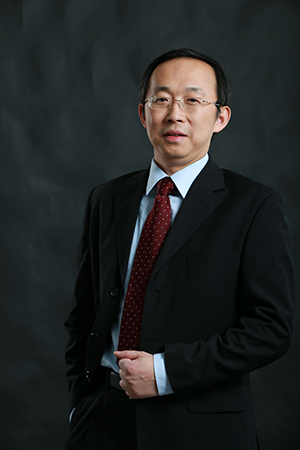
Prof. Zhiqiang Chen from Tsinghua University, Chairman, President and Chief Executive Officer, NUCTECH
Out of this toolbox, temperature screening is one of the most widely adopted measures taken by airports and airlines to address the passenger concerns over mass cross infection. “It can be fast, easy and contactless to identify febrile passengers with raised temperature, an important symptom of infection with COVID-19, providing airports with a feasible way to fight against the pandemic,” explains Prof. Zhiqiang Chen from Tsinghua University, Chairman, President and Chief Executive Officer, NUCTECH.
This May, it was reported that Heathrow Airport began to trial thermal imaging cameras to screen for entry and exit passengers with elevated body temperature in the Terminal 2 and Terminal 5 immigration halls and the main entrances to departures within Terminal 2 and Terminal 5. In cases where skin temperature exceeded a threshold, set in line with local protocols stated by medical authorities, then the passenger may be selected for additional virus-specific diagnostic tests, which could help stop the spread of viruses and infections to other people.
“To help confront the unprecedented pandemic, NUCTECH, a leading supplier of advanced security and safety solutions, has come up with innovative standalone and integrated solutions for elevated body temperature,” says Prof. Chen. “And they both could conduct health screening at a safe distance in a non-invasive and automatic way, delivering a frictionless and healthy passenger journey with minimal disruption to airport operations.”
Contactless, rapid and automatic
While social distancing and wearing personal protective equipment (PPE) could become the new normal in air travel during the pandemic and beyond, temperature screening technology as a layer of health screening measures should not lead to additional stress on passenger processes by potentially incurring extra wait time and crowd gathering.
“NUCTECH’s FeverBlock screening system, a cutting-edge binocular thermal camera system, is designed for airports to perform mass screening of people,” explains Prof. Chen. “By combining infrared thermal imaging technology with visible light technology, it could conduct skin temperature screening across multiple people automatically and rapidly at a safe distance of one to five meters, delivering a throughput of 200 people per minute. Significantly, its high throughput offers a lot of operational advantages in deployment. Whether being deployed in check-in areas, security checkpoints, or immigration halls for exit or entry screening, the frictionless fever checking does not create a bottleneck with queuing or congestion, better helping passengers to follow the social distancing rules.”
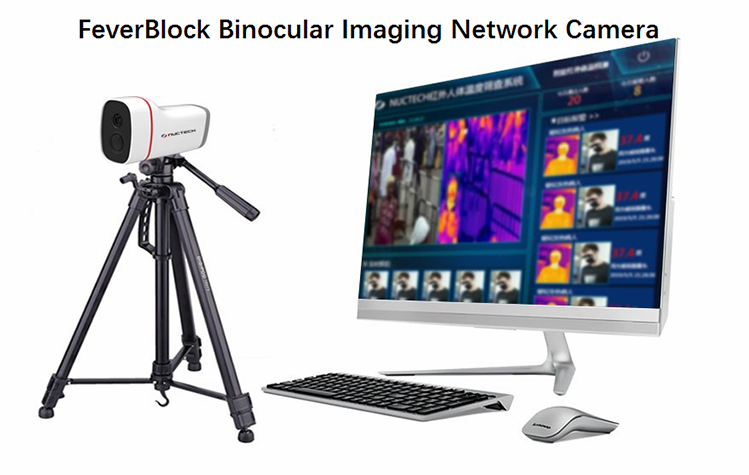
NUCTECH’s FeverBlock screening system, a cutting-edge binocular thermal camera system, is designed for airports to perform mass screening of people.
Intelligent and accurate
Artificial Intelligence (AI) is playing an important role in the evolution of the FeverBlock screening system to improve its detection accuracy and reduce false alarm rates. The embedded AI face detection algorithm can locate human faces quickly and accurately, reducing false alarms by filtering out background noises.
“Also, it is capable of self-corrections of deviation caused by distance or forehead-body temperature difference,” says Prof. Chen. “Automatic compensation calculations would minimise false positives and negatives of this kind.”
Until now, more than 1,000 FeverBlock screening systems have been deployed across the Latin America and Asia Pacific regions. “Positive feedback from customers shows its strength by successfully locating travellers with fever, assuring the effective containment of virus spreading,” Prof. Chen adds.
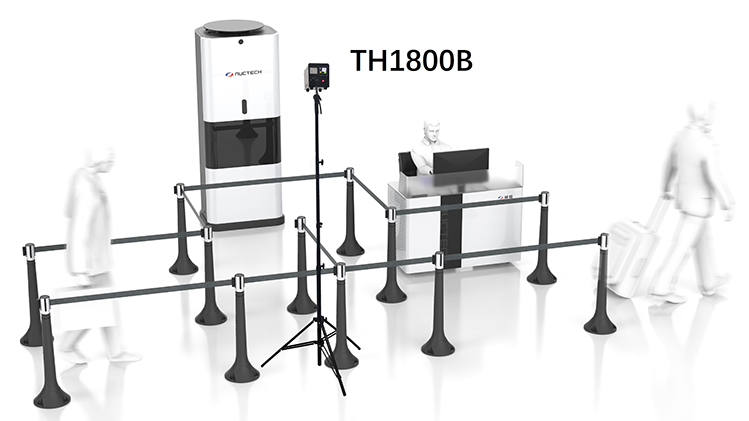
NUCTECH has developed state-of-the-art thermal imaging modules to be integrated with existing security scanners.
Seamless integration
To address concerns over virus spreading, temperature measurement has been introduced into multiple stages of the passenger journey as a safety net to filter suspect patients. In order to further streamline the screening process, NUCTECH has developed state-of-the-art thermal imaging modules to be integrated with existing security scanners and an innovative robotic platform to enhance the safety of airports.
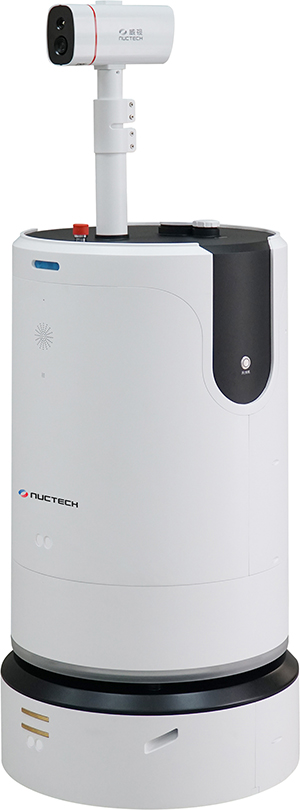
The thermal imaging module can also be mounted on NUCTECH’s iGuard robotic platform for flexible deployment.
“For instance, combined with the terahertz wave body scanner, temperature checking can be completed simultaneously with security screening,” says Prof. Chen. “With a high throughput of 2,000 persons/hour, the solution allows for passengers to go through safety and security checking in a seamless, touchless and privacy-respecting manner.”
The thermal imaging module can also be mounted on NUCTECH’s iGuard robotic platform for flexible deployment. The integrated solution can automatically patrol a pre-defined place to serve as a temporary fever-screening post, quickly responding to fluctuations in flight schedules.
Safe and secure deployment
In the COVID-19 Aviation Health Safety Protocol launched by the European Union Aviation Safety Agency (EASA) and the European Centre for Disease Prevention and Control (ECDC), it is recommended that airports deploy separate physical booths for suspected or probable cases requiring further assessment, which could prevent viral transmission to other passengers and airport staff before the medical staff arrives. Similarly, the booths should be disinfected after each use to prevent viral transmission to the next occupants.
“In this case, NUCTECH’s WeSpace physical isolation unit is coming in handy to provide airports with an ad-hoc isolation room for the suspected cases waiting for further medical assessment,” explains Prof. Chen. “WeSpace, equipped with UV disinfection technology, can be disinfected and sterilized fast and effectively after each use. Usually, thorough sterilization can be completed within half an hour to eliminate the presence of virus, preventing cross transmission to the next occupants and effectively containing the spread of contagious diseases.”
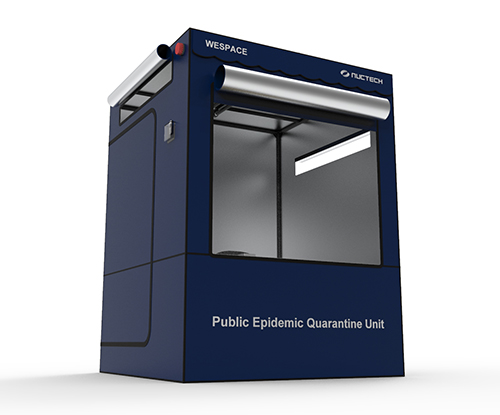
NUCTECH’s WeSpace physical isolation unit.
Equipped with a two-way communication system and a mobile tablet, the isolation room can be utilised for safe interviews and contactless medical observation. Coupled with tailor-made mobile application, it allows officials to perform epidemiological surveys for contact tracing, while protecting airport staff and passengers from risky exposure to virus.
“In the wake of a recovery from the pandemic, many airports are ramping up efforts on health screening, as a safety measure to restore passenger confidence and to improve protection of their staff,” Prof. Chen adds. “Thermal imaging systems such as FeverBlock can play an instrumental role in detecting suspected cases, and isolation booths like WeSpace could mitigate the risk of virus transmission. In return, airports with effective and efficient health screening protocols will gain a competitive edge in the post-pandemic era.”







